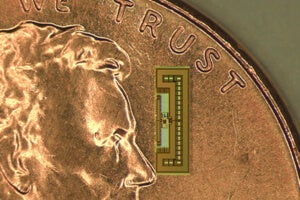Not so long ago we covered a miniature, ant-sized computer chip designed to be embedded in everyday stuff to make it smarter. Instead of a cumbersome battery in need of constant recharging—the chip is powered wirelessly by radio waves.
Now, the same Stanford group, led by assistant professor of electrical engineering Amin Arbabian, is working on a sister chip destined to be implanted in the body to keep tabs on internal biological processes and distribute drugs and other therapies.
To date, medical implants bristle with wires or, when they’re wireless, are made bulkier by onboard batteries. Ideal implants would be wireless and battery-free.

Unlike chips to be embedded in inanimate objects, implanted chips need to be fully compatible with the human body and present minimal health risk. To that end, Arbabian chose ultrasound to power his chip. Ultrasound is already safely used for sensitive procedures, like fetal imaging, and can provide the needed power.
How does it work? The chip houses a special piezoelectric material that flexes in response to incoming ultrasound waves creating a small amount of electricity.
“The implant is like an electrical spring that compresses and decompresses a million times a second, providing electrical charge to the chip,” says Marcus Weber, a Stanford graduate student who working on Arbabian’s team.
Arbabian’s team found their device responded to targeted ultrasound through three centimeters of chicken meat—their human flesh analog.
As it’s powered, the chip is designed to translate ultrasound to power, process commands for particular actions, and send back confirmation by radio. Such tasks might, in the future, include biosensing or delivering electric shocks to relieve pain or ease the worst symptoms in neurological conditions like Parkinson’s disease.
Currently, the chip is about the same size as the end of a ballpoint pen. The team is working to make the next generation of chips a tenth that size. The hope is such tiny implants might one day form a sensory network for in vivo brain research.
Arbabian’s chips may well prove forerunners to such implants, or the team’s wireless power tech might be combined with other cutting-edge implant designs.
Recently, for example, we wrote about a new graphene biosensor. The sensor is extraordinarily thin (four atoms across), transparent, flexible, and biocompatible. Because the graphene chip allows light to pass through, it lends itself to brain research using traditional imaging methods and cutting-edge optogenetics.
Whichever technology, or combination of technologies, wins out, it appears a new generation of digital technology is poised to be implanted—and that’s exciting news for pure research, medical diagnostics, and the humane therapies of tomorrow.
Image Credit: Stanford



